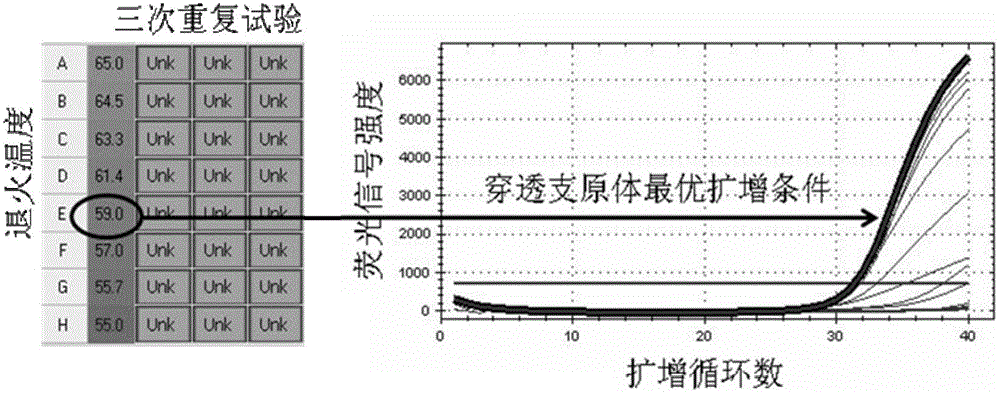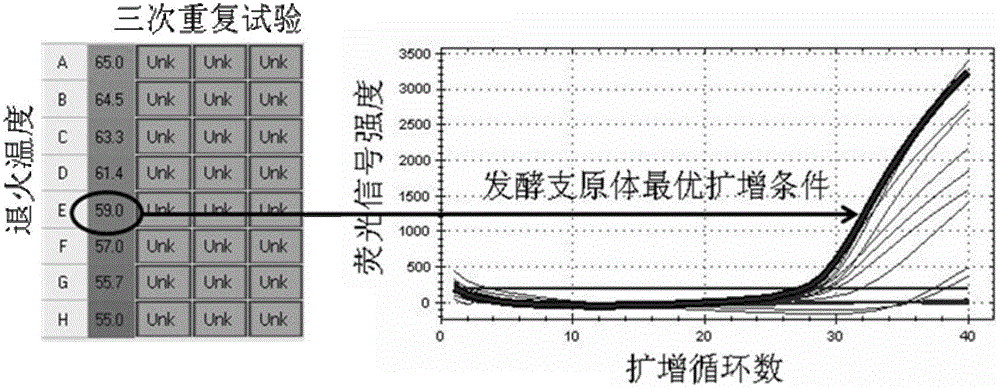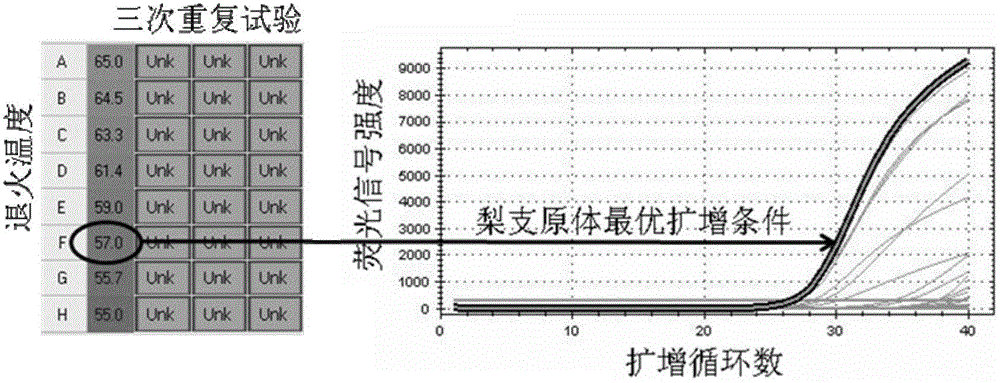Primer, probe set and kit for detecting AIDS-related mycoplasmas
A detection kit and primer combination technology, applied in the field of molecular biology, can solve the problems of increased clinical detection workload and detection cost, general PCR detection sensitivity, and reduced detection efficiency, so as to simplify the detection workload, shorten the detection time, The effect of fast sensitivity
- Summary
- Abstract
- Description
- Claims
- Application Information
AI Technical Summary
Problems solved by technology
Method used
Image
Examples
Embodiment 1 3
[0055] The design of embodiment 1 triple fluorescent PCR primers and probes
[0056] Probes and primers were designed by using the Beacon Designer7 software for the conserved regions in the ftsZ gene of Mycoplasma penetratingum, the ftsZ gene of Mycoplasma fermentans and the rpoB gene of Mycoplasma pirum reported in the NCBI database. The probe types are all TaqMan probes, in which the penetrating mycoplasma probe is 5' labeled with the fluorescent group FAM and 3' labeled with the quencher group BHQ1; the fermentation mycoplasma probe is 5' labeled with the fluorescent group HEX and 3' labeled with the quencher Group BHQ1; Mycoplasma pear probe 5' labeled fluorescent group ROX, 3' labeled quencher group BHQ2.
[0057] The primer sequence for detecting mycoplasma is:
[0058] Mpen-F:ACGTGAGTTAACCATGTA (SEQ ID NO.1)
[0059] Mpen-R: GGTTCGTCTTTCTATCTAATAG (SEQ ID NO. 2);
[0060] The primer sequence for detecting Mycoplasma fermentum is:
[0061] Mfer-F: TGCTGTTTCAATGTCATC ...
Embodiment 2 3
[0072] Example 2 The optimization of triple fluorescent quantitative PCR annealing temperature
[0073] The present invention respectively detects Mycoplasma penetrans ATCC55252, Mycoplasma fermentans ATCC19989 and Mycoplasma pirum ATCC25960 by single-plex fluorescent PCR detection ( Figure 1~3 ), and change the annealing temperature to select the optimal annealing temperature for the multiplex system. It was found that the optimal annealing temperature for the reaction of Mycoplasma penetratum and Mycoplasma fermentum was 59°C, and the optimum annealing temperature for Mycoplasma pirum was 57°C, and the amplification effect of the system was the best at this temperature. Taking the above factors into consideration, the annealing temperature range of the triple fluorescent quantitative PCR system was set at 57°C to 60°C.
Embodiment 3 3
[0074] Embodiment 3 Triple fluorescent quantitative PCR amplification system and amplification conditions
[0075] The real-time fluorescence quantitative PCR amplification system is:
[0076]
[0077]
[0078] Amplification conditions:
[0079] 95℃ 3min
[0080]
PUM
| Property | Measurement | Unit |
|---|---|---|
| Sensitivity | aaaaa | aaaaa |
Abstract
Description
Claims
Application Information
 Login to View More
Login to View More - R&D
- Intellectual Property
- Life Sciences
- Materials
- Tech Scout
- Unparalleled Data Quality
- Higher Quality Content
- 60% Fewer Hallucinations
Browse by: Latest US Patents, China's latest patents, Technical Efficacy Thesaurus, Application Domain, Technology Topic, Popular Technical Reports.
© 2025 PatSnap. All rights reserved.Legal|Privacy policy|Modern Slavery Act Transparency Statement|Sitemap|About US| Contact US: help@patsnap.com



